Minimization of Torque Deviation of Cylinder Deactivation Engine through 48V Mild-Hybrid Starter-Generator Control
Abstract
1. Introduction
2. Experimental Setup
2.1. Target Engine Description
2.2. Experimental Conditions
3. Target Engine Model and 48V MHSG Model
3.1. Model Overview
3.2. SI Turbulent Engine Model
3.3. 48V MHSG Model
3.4. Modeling Results
4. In-Cylinder Pressure Based 48V MHSG Control Strategy
4.1. Controller Overview
4.2. Engine Torque Calculation
4.3. 48V MHSG Torque Profile Generation
4.4. Dynamic Compensation of 48V MHSG
4.5. 48V MHSG Control Results
5. Conclusions
Author Contributions
Funding
Institutional Review Board Statement
Informed Consent Statement
Data Availability Statement
Conflicts of Interest
References
- Middendorf, H.; Theobald, J.; Lang, L.; Hartel, K. The 1.4-l TSI Gasoline Engine with Cylinder Deactivation. MTZ Worldw. 2012, 73, 4–9. [Google Scholar] [CrossRef]
- Michelini, J.; Glugla, C. Control System Design for Steady State Operation and Mode Switching of an Engine with Cylinder Deactivation. In Proceedings of the American Control Conference, Denver, CO, USA, 4–6 June 2003; Volume 4, pp. 3125–3129. [Google Scholar]
- Kortwittenborg, T.; Walter, F. Strategy to Control the Cylinder Deactivation. MTZ Worldw. 2013, 74, 18–22. [Google Scholar] [CrossRef]
- Bech, A.; Shayler, P.J.; McGhee, M. The Effects of Cylinder Deactivation on the Thermal Behaviour and Performance of a Three Cylinder Spark Ignition Engine. SAE Int. J. Engines 2016, 9, 1999–2009. [Google Scholar] [CrossRef]
- Leone, T.G.; Pozar, M. Fuel economy benefit of cylinder deactivation-sensitivity to vehicle application and operating constraints. In Proceedings of the SAE Technical Papers; SAE International: Warrendale, PA, USA, 2001. [Google Scholar]
- Boretti, A.; Scalco, J. Piston and valve deactivation for improved part load performances of internal combustion engines. In Proceedings of the SAE 2011 World Congress and Exhibition; SAE International: Warrendale, PA, USA, 2011. [Google Scholar]
- Lee, N.; Park, J.; Lee, J.; Park, K.; Choi, M.; Kim, W. Estimation of Fuel Economy Improvement in Gasoline Vehicle Using Cylinder Deactivation. Energies 2018, 11, 3084. [Google Scholar] [CrossRef]
- Parker, M.C.; Jiang, C.; Butcher, D.; Spencer, A.; Garner, C.P.; Witt, D. Impact and observations of cylinder deactivation and reactivation in a downsized gasoline turbocharged direct injection engine. Int. J. Engine Res. 2019, 146808741988281. [Google Scholar] [CrossRef]
- Souflas, I.; Mason, B.; Cary, M.; Schaal, P. Mode Transition Optimisation for Variable Displacement Engines. In Proceedings of the SAE Technical Papers; SAE International: Warrendale, PA, USA, 2016. [Google Scholar]
- Flierl, R.; Lauer, F.; Breuer, M.; Hannibal, W. Cylinder Deactivation with Mechanically Fully Variable Valve Train. SAE Int. J. Engines 2012, 5, 207–215. [Google Scholar] [CrossRef]
- Salim, W.S.I.W.; Mahdi, A.A.M.; Ismail, M.I.; Abas, M.A.; Martinez-Botas, R.F.; Rajoo, S. Benefits of spark-ignition engine fuel-saving technologies under transient part load operations. J. Mech. Eng. Sci. 2017, 11, 3027–3037. [Google Scholar] [CrossRef]
- An, F.; Santini, D.J. Mass Impacts on Fuel Economies of Conventional vs. Hybrid Electric Vehicles. SAE Trans. 2004, 113, 258–276. [Google Scholar]
- Bitsche, O.; Gutmann, G. Systems for hybrid cars. J. Power Sources 2004, 127, 8–15. [Google Scholar] [CrossRef]
- Reid, A. Understanding the Importance of an Energy Crisis. Ph.D. Thesis, University of Michigan, Ann Arbor, MI, USA, 2009. [Google Scholar]
- Li, Y.; Wang, S.; Duan, X.; Liu, S.; Liu, J.; Hu, S. Multi-objective energy management for Atkinson cycle engine and series hybrid electric vehicle based on evolutionary NSGA-II algorithm using digital twins. Energy Convers. Manag. 2021, 230, 113788. [Google Scholar] [CrossRef]
- Mechtenberg, A.R.; Peters, D.L. Control of a 36 Mode Hybrid Vehicle with Driver Option Selection: Incorporating Urban, Suburban, and Highway Driving; American Society of Mechanical Engineers: Fort Lauderdale, FL, USA, 2012; pp. 137–144. [Google Scholar]
- Millo, F.; Mirzaeian, M.; Luisi, S.; Doria, V.; Stroppiana, A. Engine displacement modularity for enhancing automotive s.i. engines efficiency at part load. Fuel 2016, 180, 645–652. [Google Scholar] [CrossRef]
- McGhee, M.; Wang, Z.; Bech, A.; Shayler, P.J.; Witt, D. The effects of cylinder deactivation on the thermal behaviour and fuel economy of a three-cylinder direct injection spark ignition gasoline engine. Proc. Inst. Mech. Eng. Part D J. Automob. Eng. 2019, 233, 2838–2849. [Google Scholar] [CrossRef]
- Fujiwara, M.; Kumagai, K.; Segawa, M.; Sato, R.; Tamura, Y. Development of a 6-cylinder gasoline engine with new variable cylinder management technology. In Proceedings of the SAE Technical Papers; SAE International: Warrendale, PA, USA, 2008. [Google Scholar]
- Falkowski, A.; Mcelwee, M.; Bonne, M. Design and development of the Daimlerchrysler 5.7L HEMI® engine multi-displacement cylinder deactivation system. In Proceedings of the SAE Technical Papers; SAE International: Warrendale, PA, USA, 2004. [Google Scholar]
- Chien, L.C.; Younkins, M.; Wilcutts, M. Modeling and Simulation of Airflow Dynamics in a Dynamic Skip Fire Engine. In Proceedings of the SAE Technical Papers; SAE International: Warrendale, PA, USA, 2015; Volume 2015. [Google Scholar]
- Eisazadeh-Far, K.; Younkins, M. Fuel Economy Gains through Dynamic-Skip-Fire in Spark Ignition Engines. In Proceedings of the SAE Technical Papers; SAE International: Warrendale, PA, USA, 2016. [Google Scholar]
- Ortiz-Soto, E.; Wolk, B.; Chen, H.; Younkins, M. MDSF: Improved fuel efficiency, drivability and vibrations via dynamic skip fire and miller cycle synergies. In Proceedings of the SAE Technical Papers; SAE International: Warrendale, PA, USA, 2019; Volume 2019. [Google Scholar]
- Wilcutts, M.; Switkes, J.; Shost, M.; Tripathi, A. Design and Benefits of Dynamic Skip Fire Strategies for Cylinder Deactivated Engines. SAE Int. J. Engines 2013, 6, 278–288. [Google Scholar] [CrossRef]
- Serrano, J.; Routledge, G.; Lo, N.; Shost, M.; Srinivasan, V.; Ghosh, B. Methods of Evaluating and Mitigating NVH when Operating an Engine in Dynamic Skip Fire. SAE Int. J. Engines 2014, 7, 1489–1501. [Google Scholar] [CrossRef]
- Wilcutts, M.; Nagashima, M.; Eisazadeh-Far, K.; Younkins, M.; Confer, K. Electrified Dynamic Skip Fire (eDSF): Design and Benefits. In Proceedings of the SAE Technical Papers; SAE International: Warrendale, PA, USA, 2018; Volume 2018. [Google Scholar]
- Wang, S.; Prucka, R.; Zhu, Q.; Prucka, M.; Dourra, H. A Real-Time Model for Spark Ignition Engine Combustion Phasing Prediction. SAE Int. J. Engines 2016, 9, 1180–1190. [Google Scholar] [CrossRef]
- Gamma Technologies. GT-SUITE Engine Performance Application Manual; Gamma Technologies: Westmont, IL, USA, 2018. [Google Scholar]
- Wang, J.; Duan, X.; Liu, Y.; Wang, W.; Liu, J.; Lai, M.-C.; Li, Y.; Guo, G. Numerical investigation of water injection quantity and water injection timing on the thermodynamics, combustion and emissions in a hydrogen enriched lean-burn natural gas SI engine. Int. J. Hydrog. Energy 2020, 45, 17935–17952. [Google Scholar] [CrossRef]
- Duan, X.; Liu, Y.; Liu, J.; Lai, M.-C.; Jansons, M.; Guo, G.; Zhang, S.; Tang, Q. Experimental and numerical investigation of the effects of low-pressure, high-pressure and internal EGR configurations on the performance, combustion and emission characteristics in a hydrogen-enriched heavy-duty lean-burn natural gas SI engine. Energy Convers. Manag. 2019, 195, 1319–1333. [Google Scholar] [CrossRef]
- Heywood, J.B. Internal Combustion Engine Fundamentals; McGraw-Hill: New York, NY, USA, 1988. [Google Scholar]
- Hires, S.D.; Tabaczynski, R.J.; Novak, J.M. The Prediction of Ignition Delay and Combustion Intervals for a Homogeneous Charge, Spark Ignition Engine; SAE International: Warrendale, PA, USA, 1978. [Google Scholar]
- Blizard, N.C.; Keck, J.C. Experimental and Theoretical Investigation of Turbulent Burning Model for Internal Combustion Engines; SAE International: Warrendale, PA, USA, 1974. [Google Scholar]
- Morel, T.; Rackmil, C.I.; Keribar, R.; Jennings, M.J. Model for Heat Transfer and Combustion In Spark Ignited Engines and its Comparison with Experiments; SAE International: Warrendale, PA, USA, 1988. [Google Scholar]
- Han, D.; Park, J.; Lim, H.; Hong, S.; Lee, J.; Choi, K.; Oh, H.; Park, Y.; Chu, D.H.; Lee, H. Engine System. US20,190,128,219A1, 2 May 2019. [Google Scholar]
- Zhao, J.; Xi, Q.; Wang, S.; Wang, S. Improving the partial-load fuel economy of 4-cylinder SI engines by combining variable valve timing and cylinder-deactivation through double intake manifolds. Appl. Therm. Eng. 2018, 141, 245–256. [Google Scholar] [CrossRef]
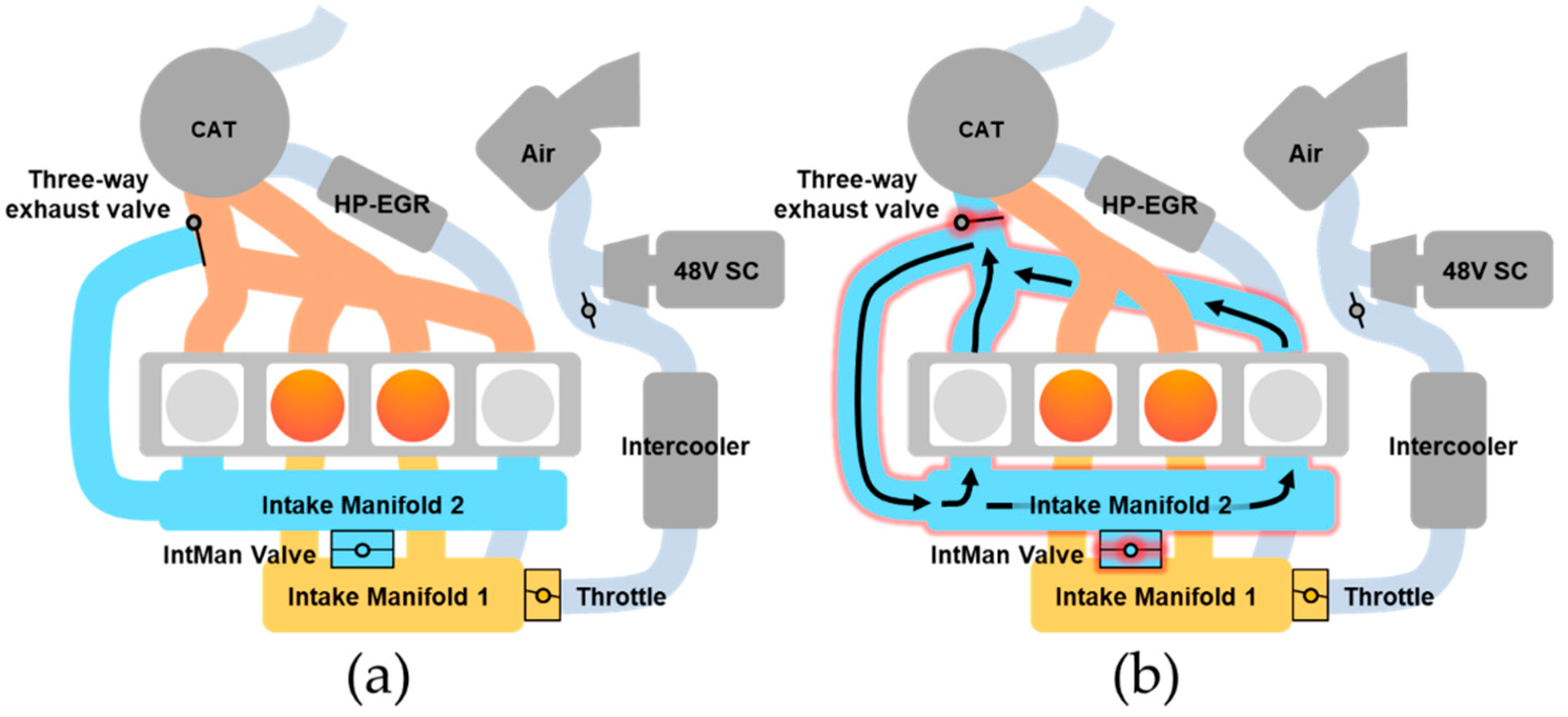
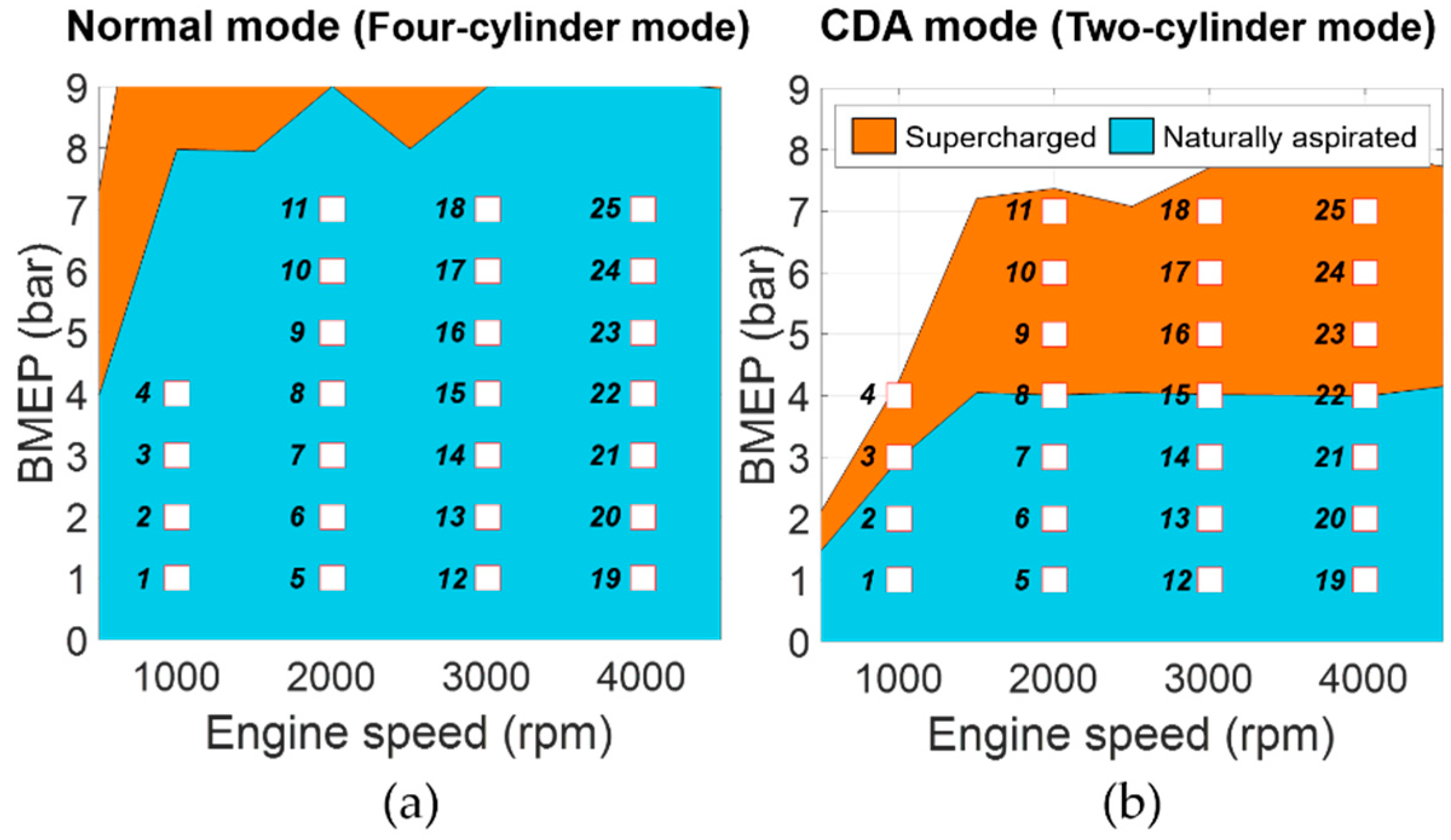


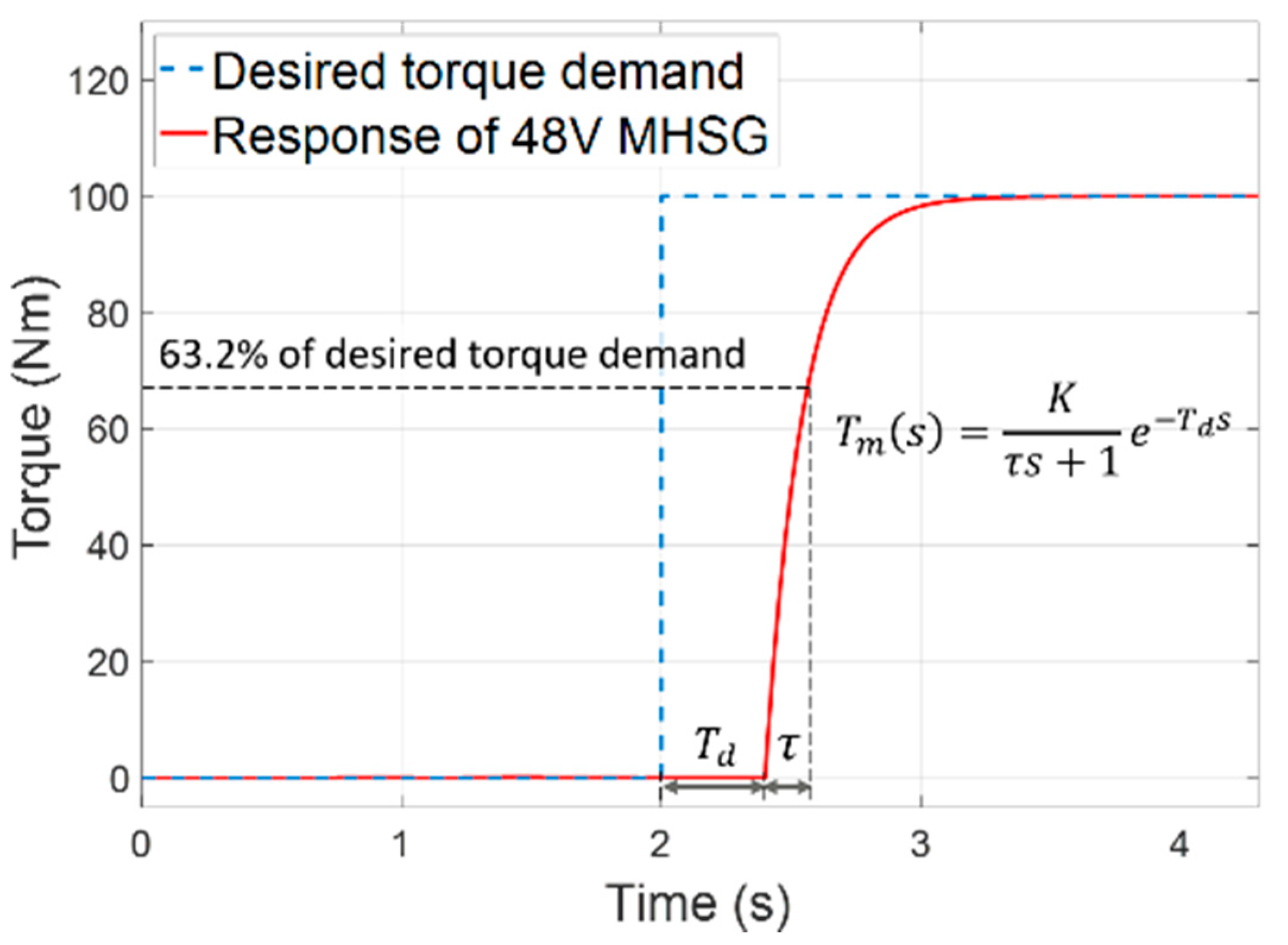
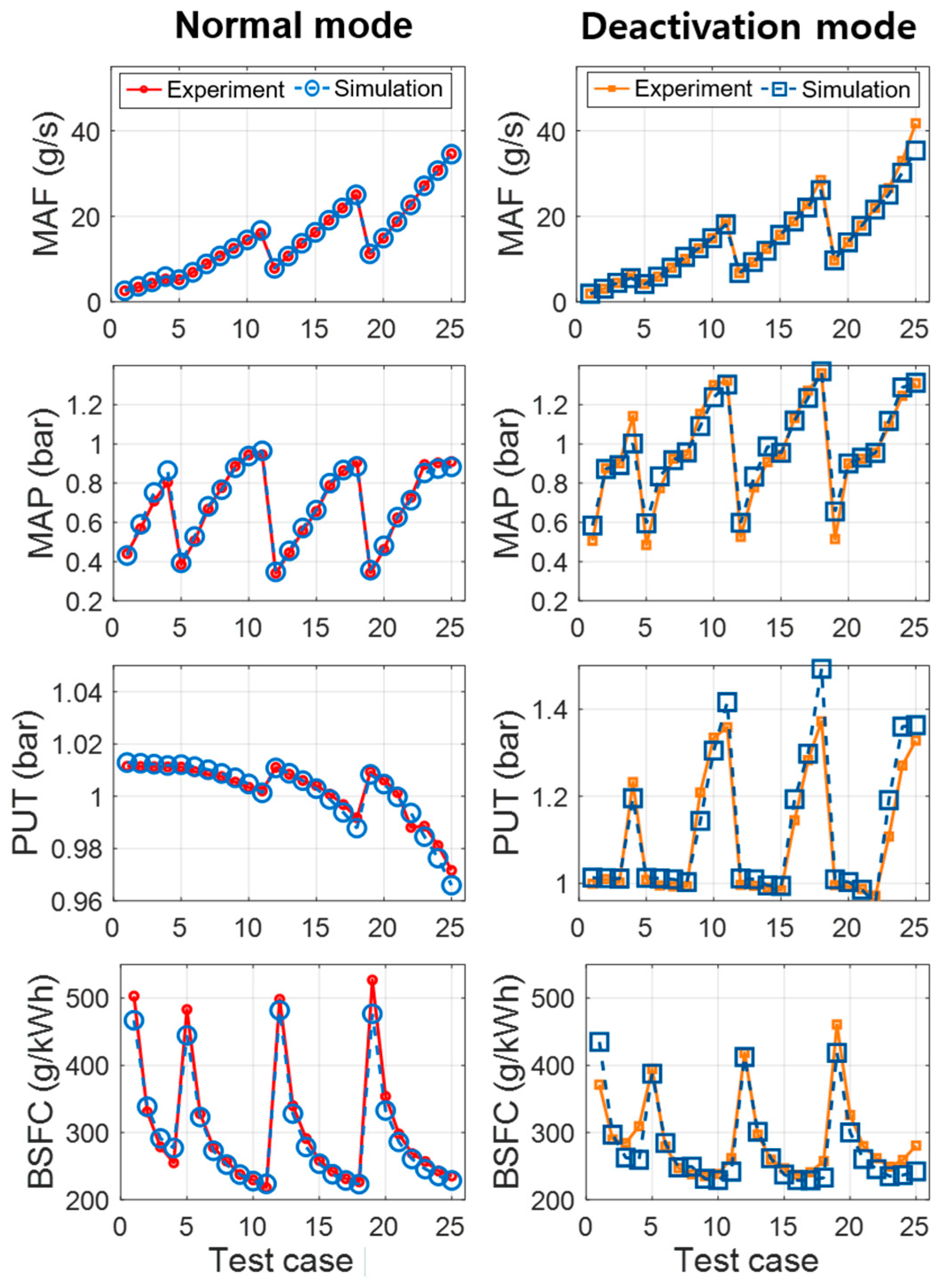

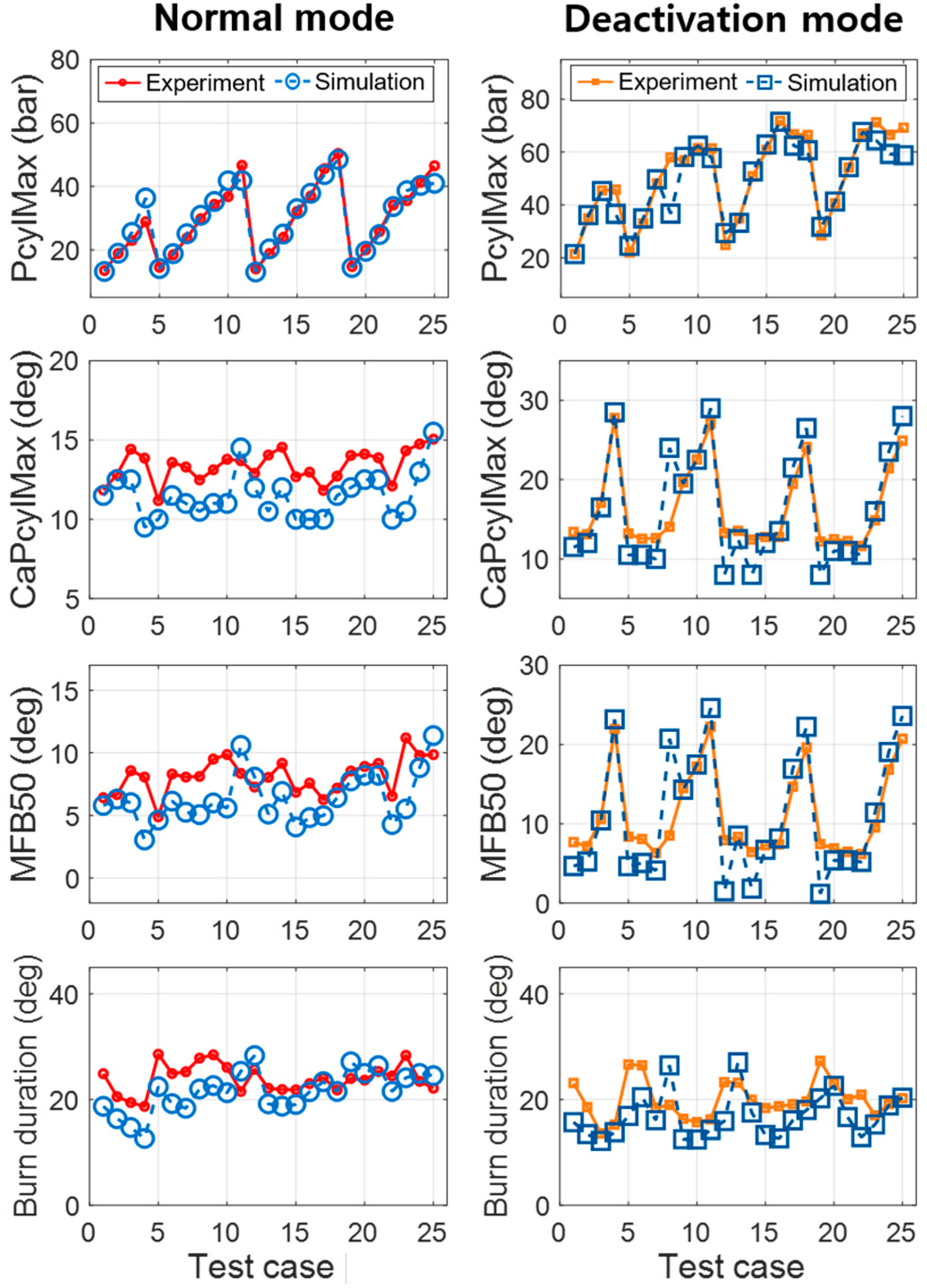
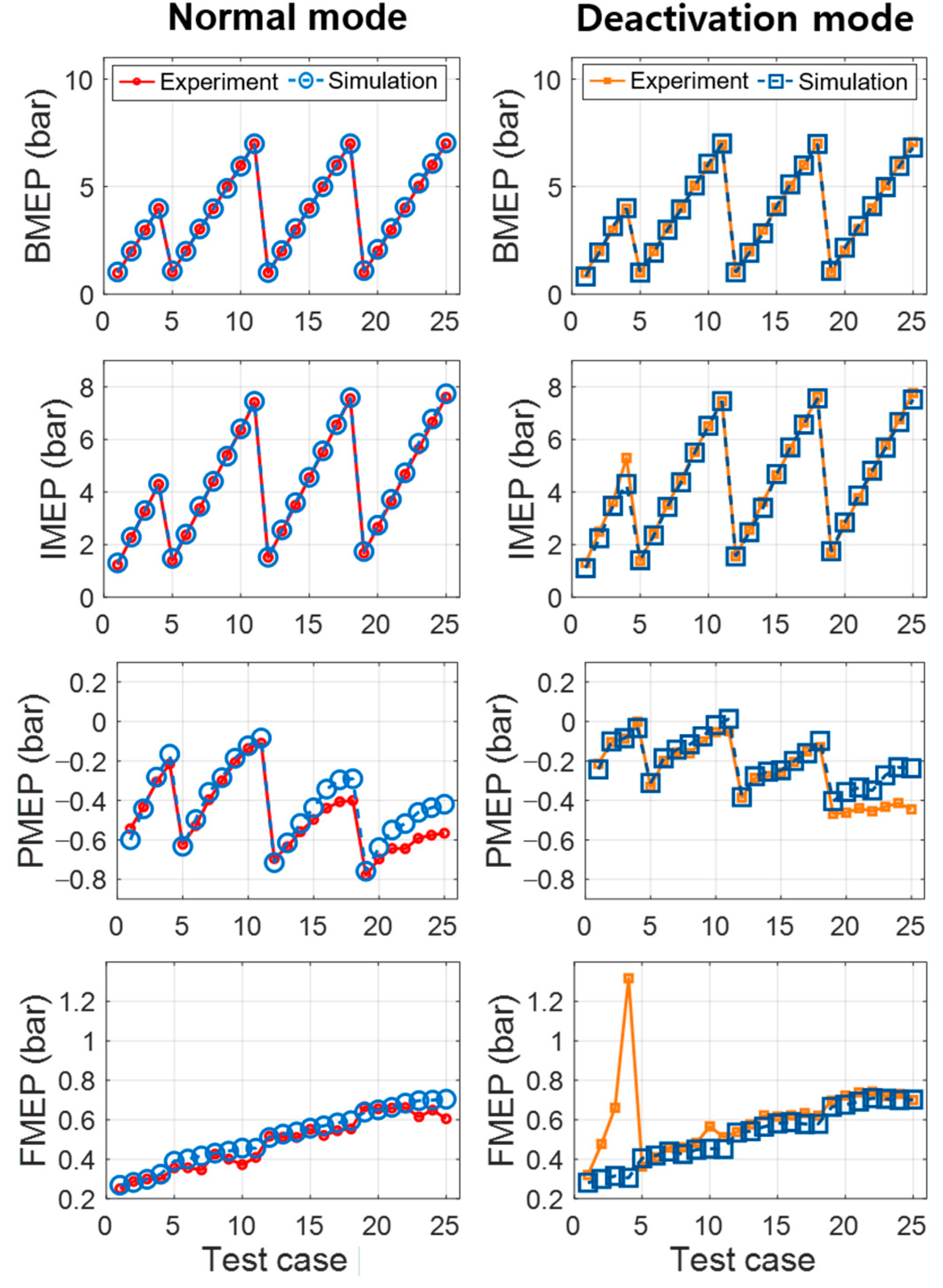

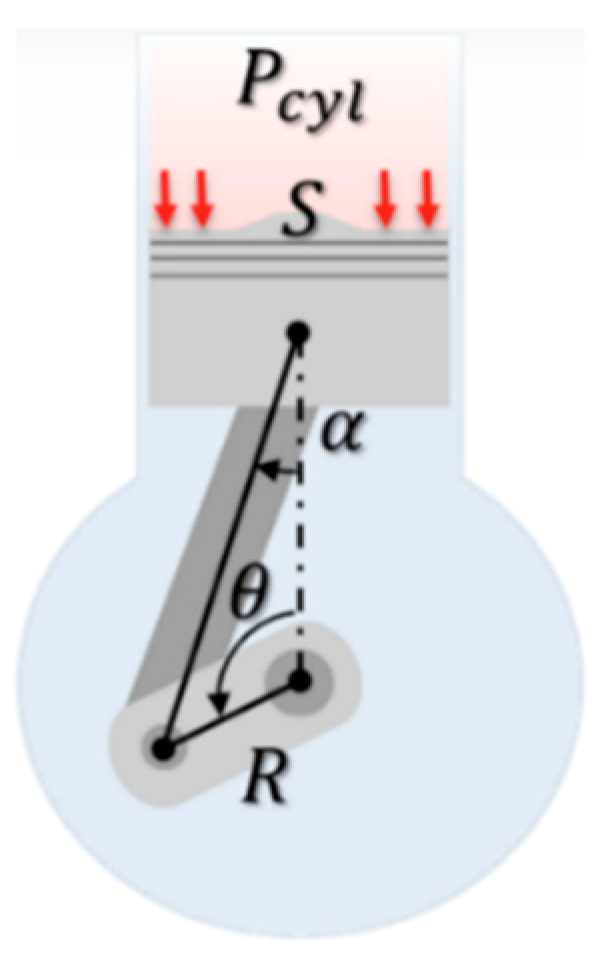
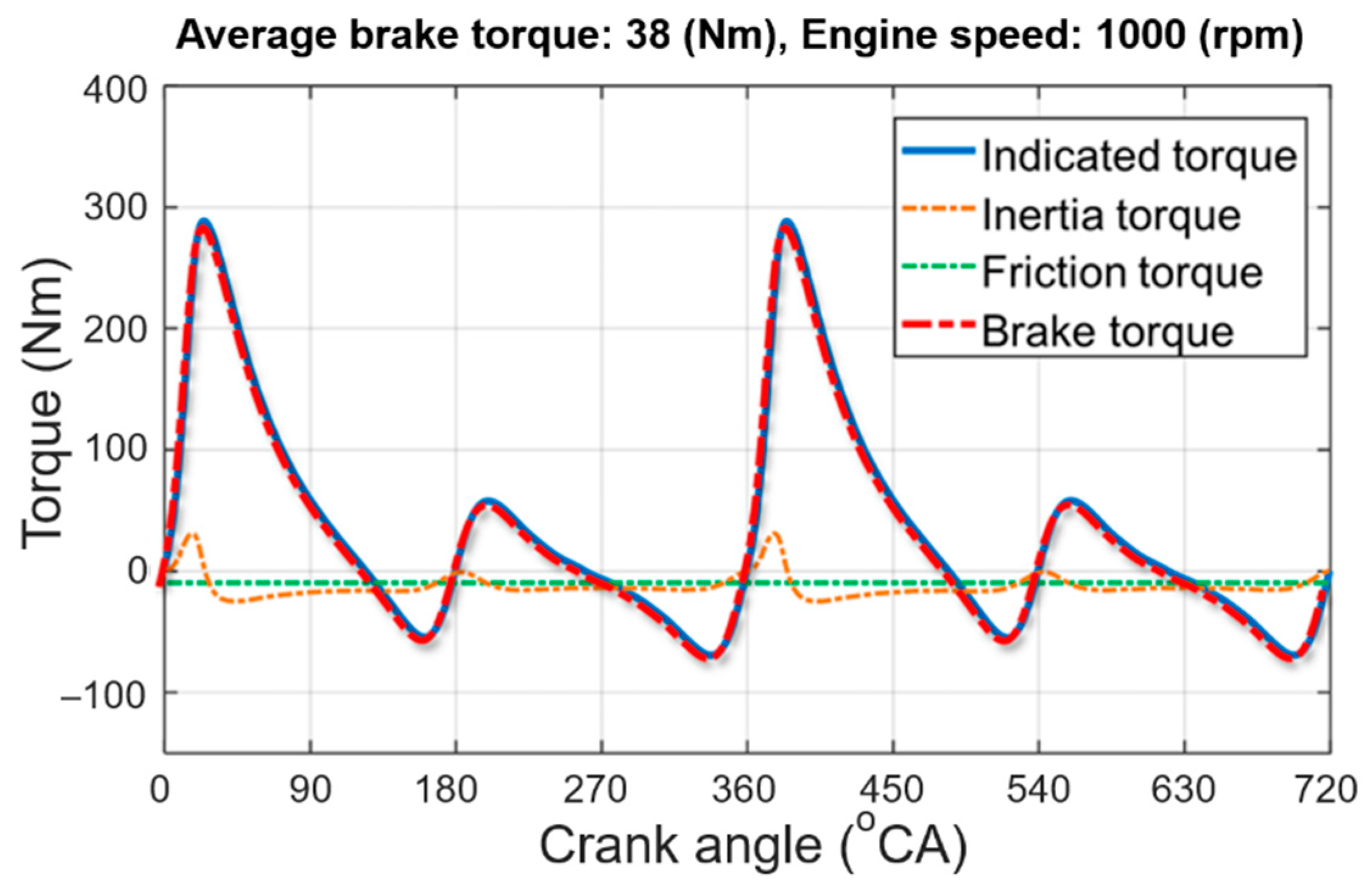
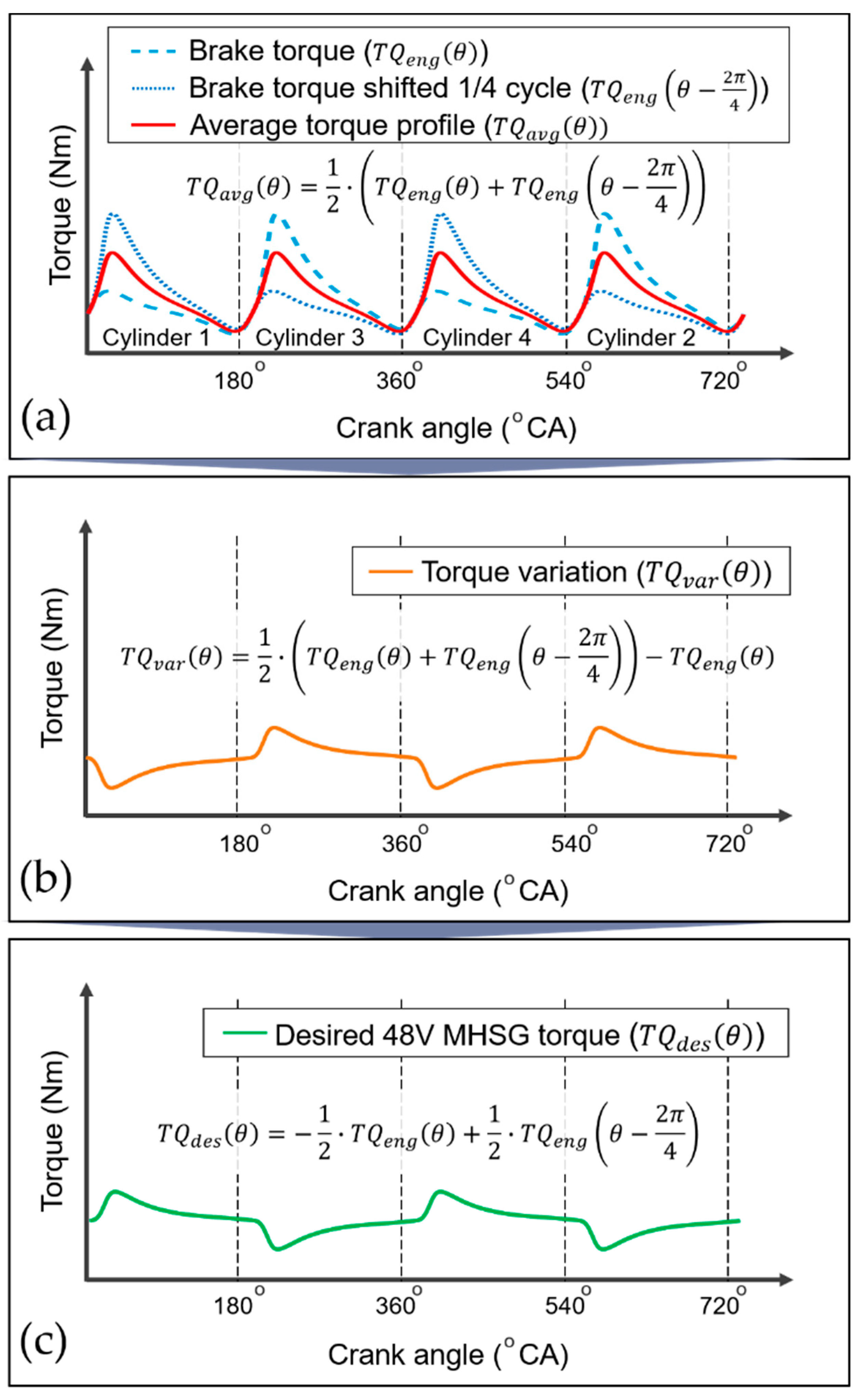

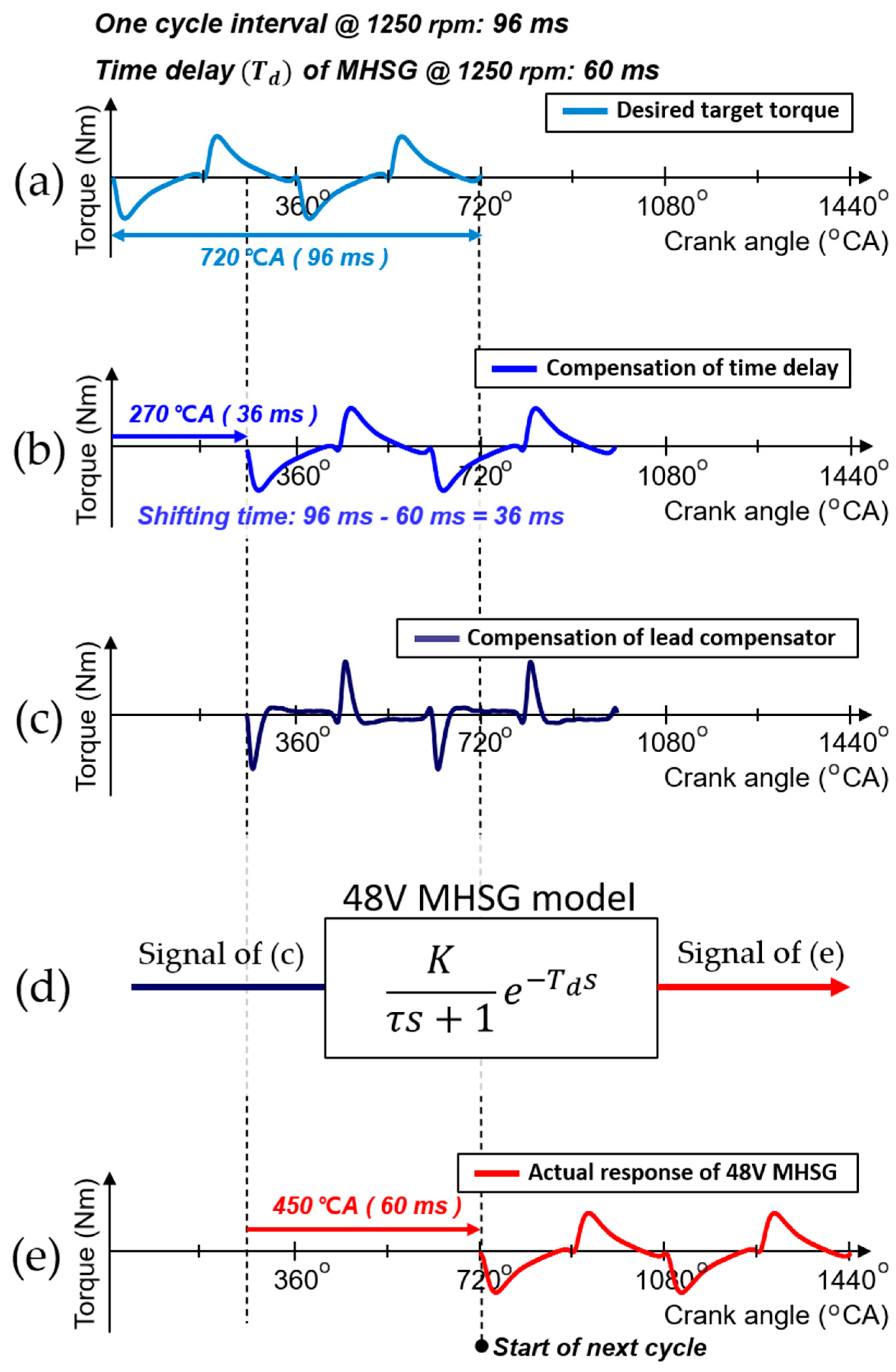
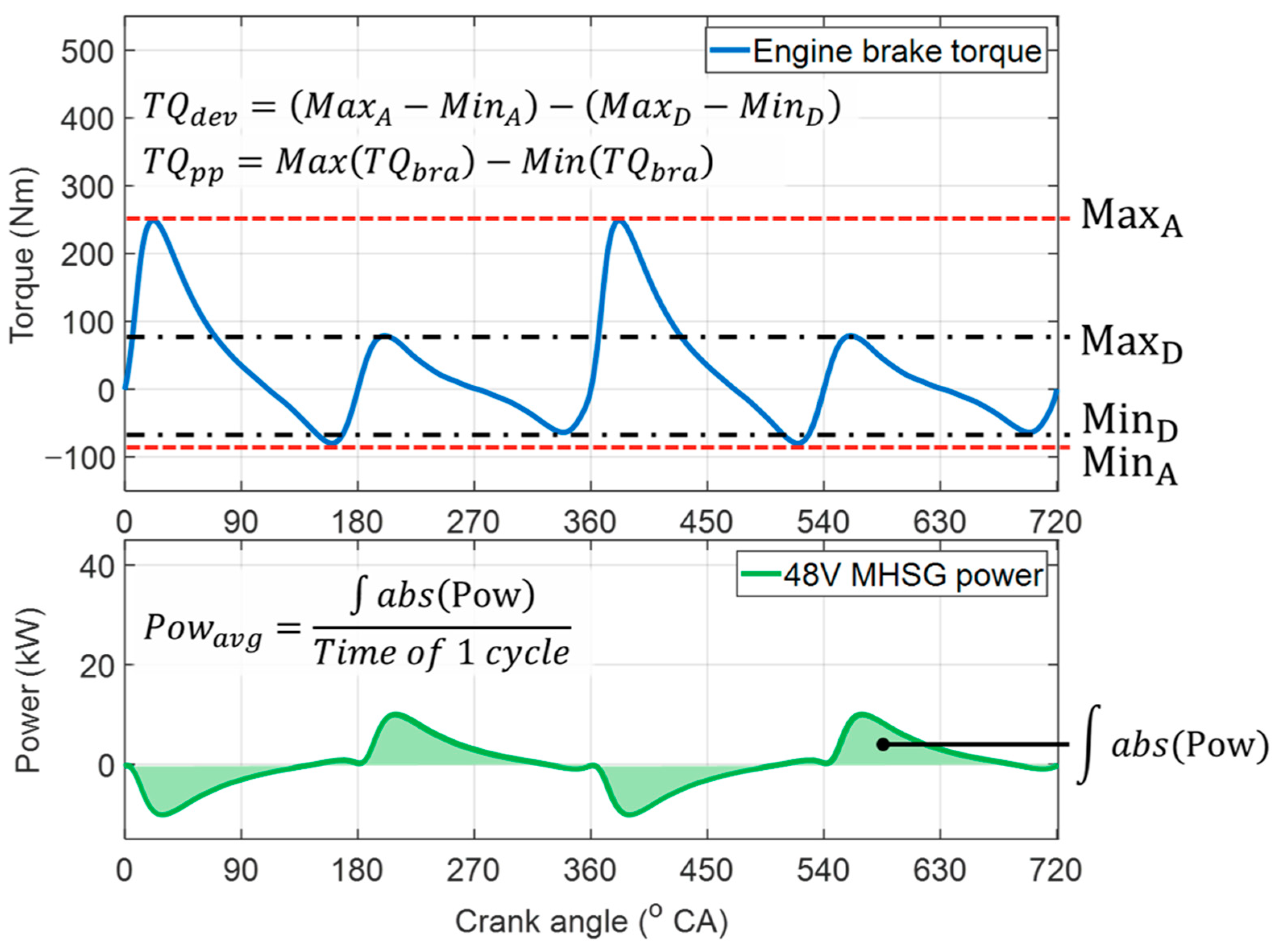
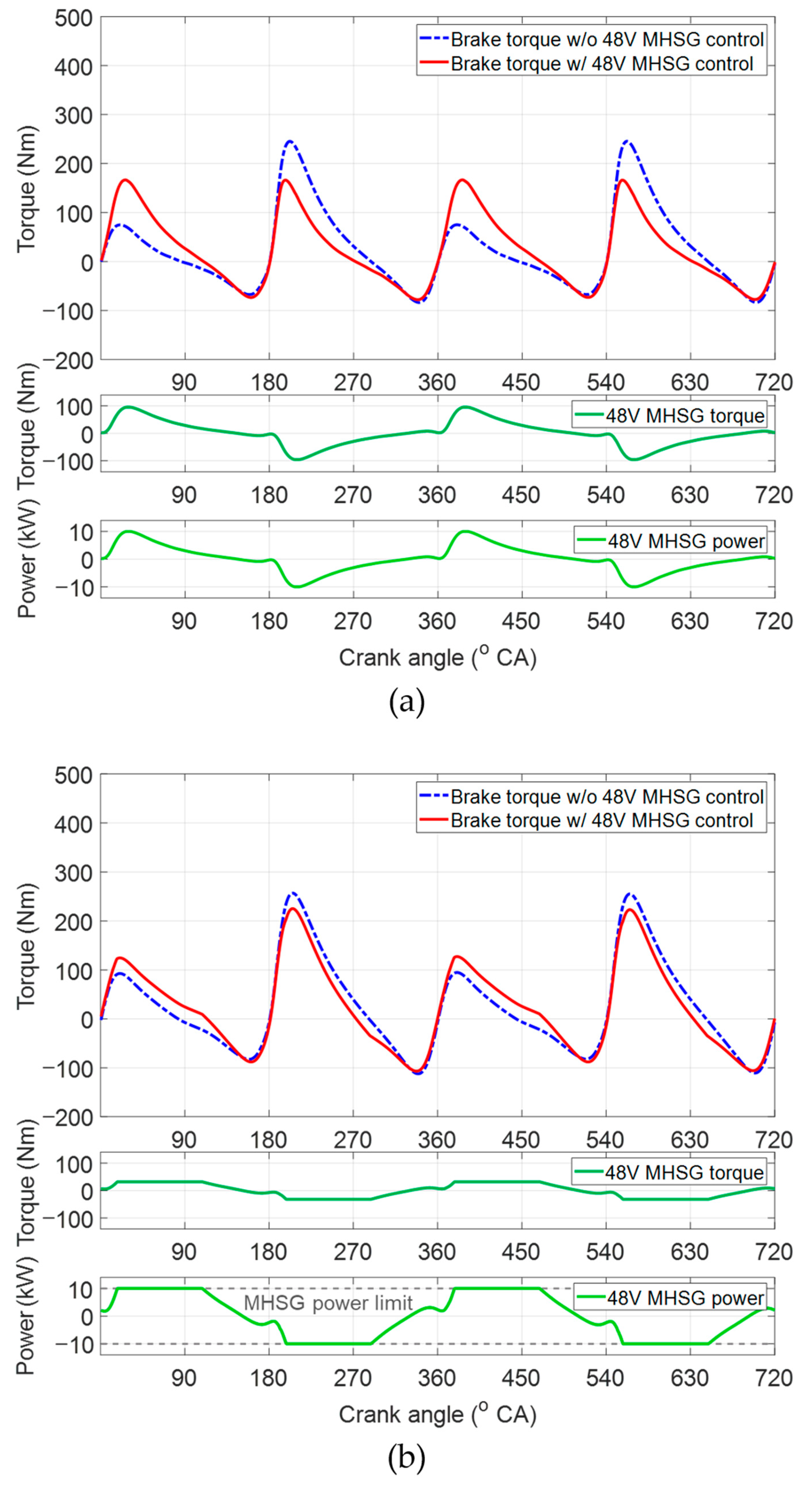
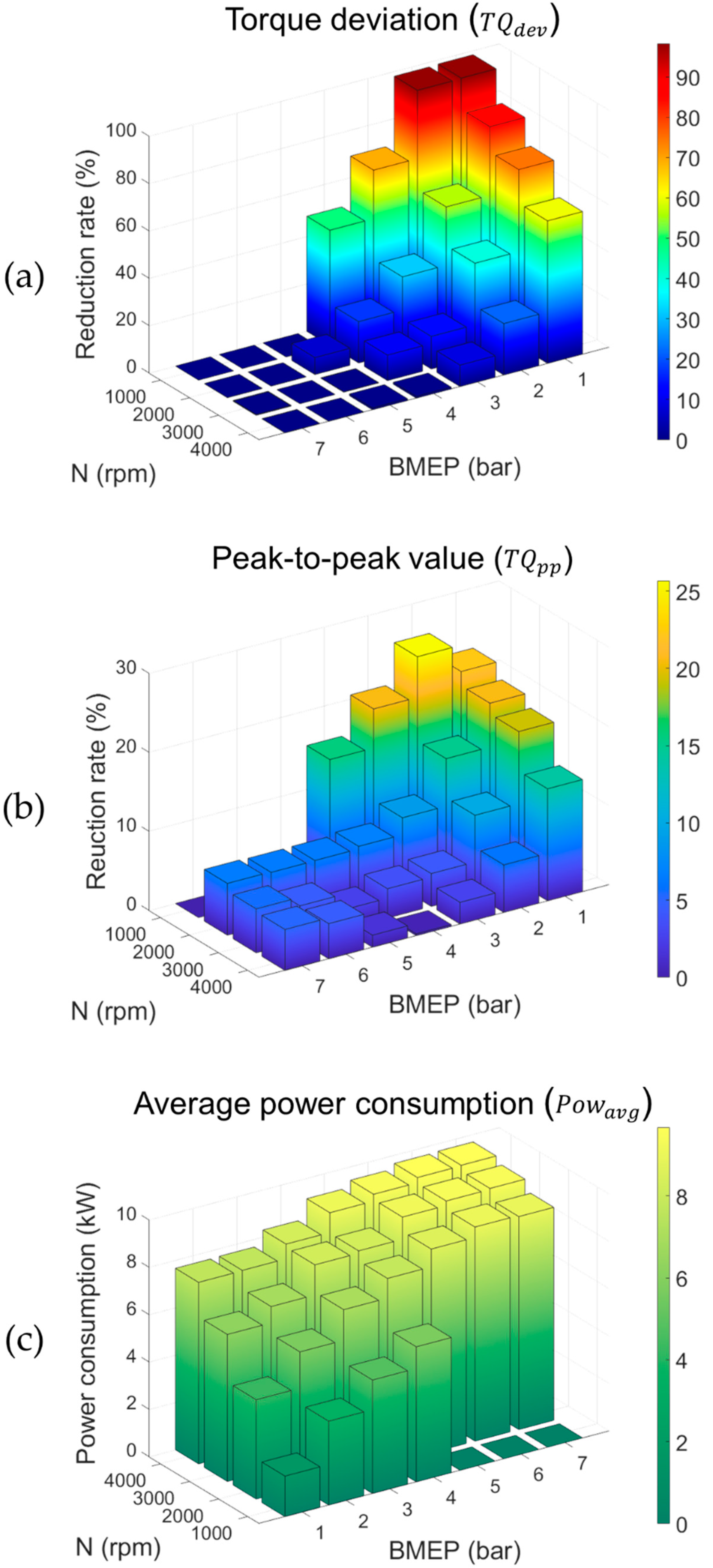
| Description | Specifications |
|---|---|
| Engine type | Gasoline direct injection (GDI), Inline, Double overhead camshaft (DOHC) |
| Number of cylinders | 4 |
| Bore × stroke (mm) | 72 × 97 |
| Connecting rod (mm) | 152.2 |
| Displacement volume (L) | 1.580 |
| Compression ratio | 12:1 |
| Applied technologies | Cylinder deactivation (CDA) with separated manifolds architecture |
| External high-pressure EGR (HP-EGR) | |
| Intake/exhaust variable valve timing (VVT) | |
| Intercooler | |
| 48V electric supercharger | |
| 48V mild-hybrid starter-generator (MHSG) |
| Description | Specifications |
|---|---|
| Pulley ratio | 2.67 |
| Maximum and minimum power | ±10 kW |
| Maximum and minimum torque | ±100 Nm |
| Normal Mode (Four-Cylinder Operation) | Deactivation Mode (Two-Cylinder Operation) | |||
|---|---|---|---|---|
| RMSE | RMSE | |||
| MAF (g/s) | 0.999 | 0.019 | 0.995 | 0.154 |
| MAP (bar) | 0.994 | 0.002 | 0.983 | 0.006 |
| PUT (bar) | 0.986 | 0.002 | 0.973 | 0.004 |
| BSFC (g/kWh) | 0.993 | 1.748 | 0.941 | 2.363 |
| Normal Mode (Four-Cylinder Operation) | Deactivation Mode (Two-Cylinder Operation) | |||
|---|---|---|---|---|
| RMSE | RMSE | |||
| PcylMax (bar) | 0.972 | 0.261 | 0.939 | 0.590 |
| CaPcylMax (deg) | 0.560 | 0.221 | 0.924 | 0.299 |
| MFB50 (deg) | 0.424 | 0.253 | 0.901 | 0.365 |
| Burn duration (deg) | 0.500 | 0.410 | 0.529 | 0.484 |
| Normal Mode (Four-Cylinder Operation) | Deactivation Mode (Two-Cylinder Operation) | |||
|---|---|---|---|---|
| RMSE | RMSE | |||
| BMEP (bar) | 0.999 | 0.005 | 0.998 | 0.011 |
| IMEP (bar) | 0.999 | 0.014 | 0.994 | 0.037 |
| PMEP (bar) | 0.949 | 0.008 | 0.861 | 0.013 |
| FMEP (bar) | 0.973 | 0.004 | 0.260 | 0.022 |
Publisher’s Note: MDPI stays neutral with regard to jurisdictional claims in published maps and institutional affiliations. |
© 2021 by the authors. Licensee MDPI, Basel, Switzerland. This article is an open access article distributed under the terms and conditions of the Creative Commons Attribution (CC BY) license (http://creativecommons.org/licenses/by/4.0/).
Share and Cite
Shin, H.; Jung, D.; Han, M.; Hong, S.; Han, D. Minimization of Torque Deviation of Cylinder Deactivation Engine through 48V Mild-Hybrid Starter-Generator Control. Sensors 2021, 21, 1432. https://doi.org/10.3390/s21041432
Shin H, Jung D, Han M, Hong S, Han D. Minimization of Torque Deviation of Cylinder Deactivation Engine through 48V Mild-Hybrid Starter-Generator Control. Sensors. 2021; 21(4):1432. https://doi.org/10.3390/s21041432
Chicago/Turabian StyleShin, Hyunki, Donghyuk Jung, Manbae Han, Seungwoo Hong, and Donghee Han. 2021. "Minimization of Torque Deviation of Cylinder Deactivation Engine through 48V Mild-Hybrid Starter-Generator Control" Sensors 21, no. 4: 1432. https://doi.org/10.3390/s21041432
APA StyleShin, H., Jung, D., Han, M., Hong, S., & Han, D. (2021). Minimization of Torque Deviation of Cylinder Deactivation Engine through 48V Mild-Hybrid Starter-Generator Control. Sensors, 21(4), 1432. https://doi.org/10.3390/s21041432







